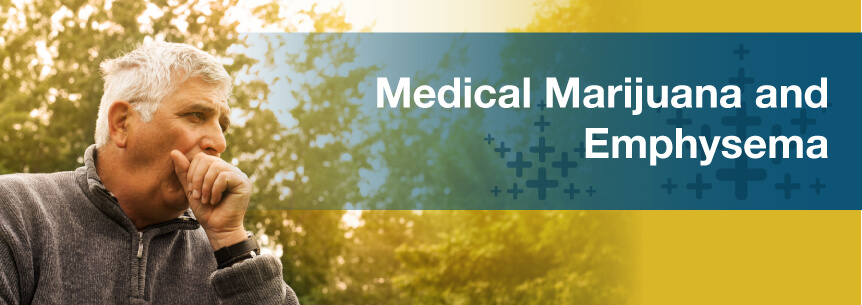
Many states have approved medical cannabis for a multitude of qualifying conditions, and the list of ailments qualifying for marijuana keeps growing. Below we learn about emphysema and the role medical marijuana can play in dealing with the condition.
Smoking cigarettes is the leading risk factor for developing this form of COPD. Since cannabis contains some of the same chemicals and toxins as cigarettes, some are concerned it may also be toxic for your lungs. However, there’s no conclusive link between smoke from weed and damaged lungs.
Also, only several smaller studies have reported a connection between lung cancer and marijuana. However, either researchers used sample sizes that were too small for the studies, or smoking tobacco was not limited as a control factor, so they couldn’t draw a causal connection conclusively.
Find A Doctor Find A Dispensary
Research shows medical marijuana’s strong anti-inflammatory properties could actually help with treating emphysema as well as weight loss and insomnia.
A study in the 1970s compared edible cannabis to albuterol — typically the first medication patients with problems breathing get. Researchers found marijuana acted as a bronchodilator, just like albuterol.
In another published study in 1975 by the American Review of Respiratory Disease, scientists used an induced asthma model in which they induced bronchospasms (airway contractions) in healthy participants in an attempt to replicate asthma. They found cannabis with only two percent THC help relieve bronchospasm symptoms. A lot of medical cannabis for emphysema strains these days have over 10 to 20 percent THC.
After the participants smoked 0.5 grams of the test cannabis, they immediately recovered from the over inflation of their lungs and the bronchospasms.
There is increasing research and study into the efficacy of marijuana for inflammation, particularly concerning Chron’s disease, which is often debilitating. The very first study published on the topic showed there was a significant reduction in symptoms, need for other medications and even surgeries among patients who were given medical marijuana to treat their Chron’s disease.
With this success has come the idea medical marijuana can help with other forms of inflammation, and it appears certain components of the marijuana plant can do just that. As inflammation can increase difficulty breathing in patients with emphysema, it follows that medical marijuana may prove to be an effective treatment for emphysema and other chronic obstructive pulmonary diseases in that regard.
Interestingly, inhaled marijuana can act as a small airway bronchodilator, which is a treatment for conditions like asthma and emphysema. According to one study, the effect lasts at least two hours. The problem with this treatment is inhaled marijuana is not a treatment option for individuals with emphysema.
However, vaporized marijuana is considered much safer and may eventually be widely considered a safe alternative by the medical community. It is certainly a safer alternative, but whether it is a safe replacement for existing bronchodilators in emphysema patients remains to be seen. The goal is to prevent damage to the lungs, and other treatments may be more helpful in that area, despite the fact medical marijuana definitely works. The benefits have to outweigh the risks, and the medicine chosen must be the safest possible.
Medical marijuana for emphysema may provide relief from the side effects of the condition, including:
Treatment for emphysema includes inhaled or ingested anti-inflammatory medication, steroids, oxygen therapy, antibiotics to eliminate respiratory infections that may cause more damage, avoiding all kinds of smoke, surgery to remove diseased parts of the lung, lung transplants and diet changes. Treatment for complications, such as collapsed lung and pneumonia, may also be warranted.
As mentioned above, there is currently no known cure for emphysema. While medical marijuana is known to be an efficient treatment for a number of conditions, there is no evidence at this time it can cure emphysema. Therefore, individuals should follow the advice of their physicians when trying to slow the progression of emphysema and make life more comfortable.
Medical marijuana and marijuana derivatives may help with some symptoms. However, smoke should be avoided by emphysema sufferers at all times. Therefore, inhaled marijuana should not be considered as a treatment for emphysema. Luckily, there are several other methods of obtaining the medicinal components of marijuana without having to inhale it. It can be eaten, taken as a pill, injected and even administered topically.
Lung diseases like emphysema can cause pain while breathing. Treatment for this pain will depend on the severity of it. Mild to moderate pain can be treated with medical marijuana. Both THC and the non-psychoactive cannabinoids in medical marijuana have been shown to act as pain relievers in various studies. Studies conducted at the University of California, San Francisco, showed marijuana cannabinoids could decrease pain in chronic pain sufferers, thus decreasing the amount of potentially hazardous medications they must ingest to be pain free. A double-blind study utilizing placebo controls showed THC administered with codeine in cancer patients offered much more pain relief than those who were given a placebo rather than THC.
Studies show cannabis and emphysema treatment provides potential therapeutic benefits to managing inflammation induced acute airway constriction attacks. Because of this, it’s seen as a preventative measure for COPD patients. Numerous studies show cannabis reduces inflammation, thereby suggesting it’s an effective treatment for managing inflamed airways in patients who have chronic bronchitis.
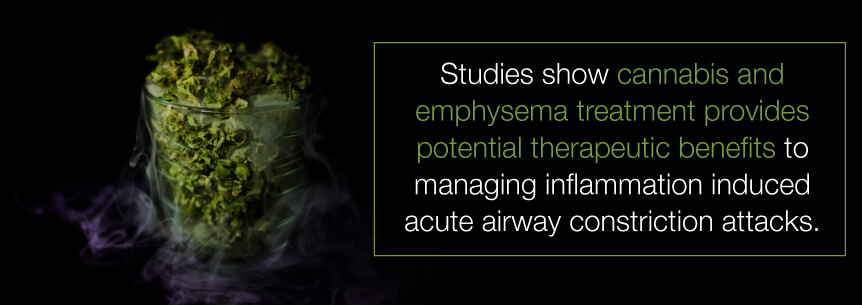
CBD improves lung function due to its potent anti-inflammatory effect, which suggests it also is a therapeutic treatment of inflammatory lung diseases.
COPD produces physiological symptoms like:
Since COPD can be difficult to treat due to problems with alveolar wall formation stimulation, the goal is mainly focused on treating the symptoms of the condition instead of slowing or healing its progression.
COPD patients may find relief from cannabis and emphysema and COPD treatment because cannabinoids can:
The best strains for COPD symptoms are indica-dominant hybrids, but others may help, too. Some strains you may want to try for symptoms of COPD include:
Smoking these strains may not benefit you as much as other methods if you’re suffering with a respiratory condition. The good news is there are other effective methods.
Many people prefer alternatives to smoking marijuana-and-emphysema strains like:
Do a little experimenting on your own to find the best method for your symptoms.
Begin the process of getting your medical marijuana card and to start feeling relief. Search for a medical marijuana dispensary or look for a doctor to commence your medical cannabis treatment.
Find A Doctor Find A Dispensary
Emphysema is a condition of the lungs that makes you short of breath. Patients have damaged alveoli, or lung air sacs, in some instances of the disease.
The air sacs’ inner walls weaken and rupture over time, which causes larger air spaces instead of numerous little ones. When this happens, the surface area of your lungs reduces and limits how much oxygen gets into your bloodstream. When exhaling, your damaged air sacs don’t work as they should. They trap old air and don’t leave enough room for the new, fresh oxygen to enter.
Often emphysema patients have chronic bronchitis, too. This condition is where your bronchial tubes become inflamed and cause you to have a persistent cough. Chronic bronchitis and emphysema are two types of COPD, or chronic obstructive pulmonary disease. COPD is an overall term for several different types of pulmonary disease, and the term sometimes can include asthma and bronchiectasis.
Two main causes of emphysema are known to exist. These are:
Tobacco smoke is the primary culprit most of the time. While physicians aren’t quite sure how tobacco smoke damages your air sac linings, WebMD reports people who smoke are six times more likely to develop emphysema. And, according to the National Heart, Lung, and Blood Institute, among patients with COPD, up to 75 percent of them either smoke or did smoke.
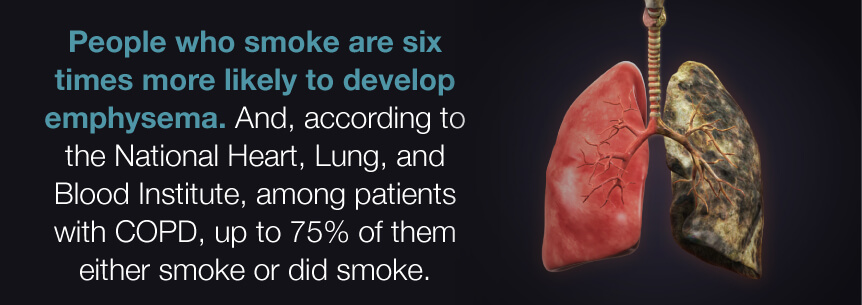
Emphysema doesn’t have a cure, but if you smoke with the condition and decide to quit, it can help slow down any damage smoking causes to your lungs.
AAT stands for Alpha-1 antitrypsin and is a natural protein circulating in your blood. It’s responsible for keeping your white blood cells from causing any damage to your healthy tissues. These cells are vital for fighting infections. Over time, if you have a serious AAT deficiency, you may develop emphysema.
Two primary types of emphysema are:
COPD isn’t a new disorder. Doctors, in the past, may have called it by different names, though. Swiss physician Théophile Bonet called it “voluminous lungs” in 1679, while Italian anatomist Giovanni Morgagni in 1769 made a report of 19 incidences of “turgid” lungs.
British physician Charles Badham referred to chronic bronchitis in 1814 as part of COPD and a disabling health condition. He described the excessive mucus and ongoing cough as “catarrh.” In 1821, Physician René Laënnec, the inventor of the stethoscope, identified emphysema as being another COPD component.
You may experience signs and symptoms of emphysema such as:
You may go years without symptoms and still have emphysema. Shortness of breath is the primary symptom of emphysema and tends to begin gradually. For instance, you might only notice a shortness of breath during exercise. However, eventually, you’ll probably begin experiencing shortness of breath while resting, too.
As your emphysema worsens over time, you may begin to lose your appetite, feel tired, have poor sexual functioning and feel depressed. But, before this happens, your only symptoms might be a slow occurrence of shortness of breath and fatigue — and it’s easy for you to mistake these for other conditions. With emphysema, you’re also at a higher risk of bronchitis, pneumonia and other lung infections.
Consult with your physician if you experience any of these following symptoms:
Also, get medical attention right away if you can’t climb stairs due to shortness of breath, you aren’t mentally alert or your fingernails or lips turn gray or blue with exertion.
In many cases, you may not notice symptoms until you have damage to over half of your lung tissue, according to the Cleveland Clinic.
Physical complications of emphysema can include:
Along with the physical effects of emphysema, numerous cognitive and psychological difficulties may result from emphysema. Behavioral and psychological changes can affect COPD patients. There’s 30 to 50 percent psychiatric disorder prevalence based off a thorough review of over 80 studies.
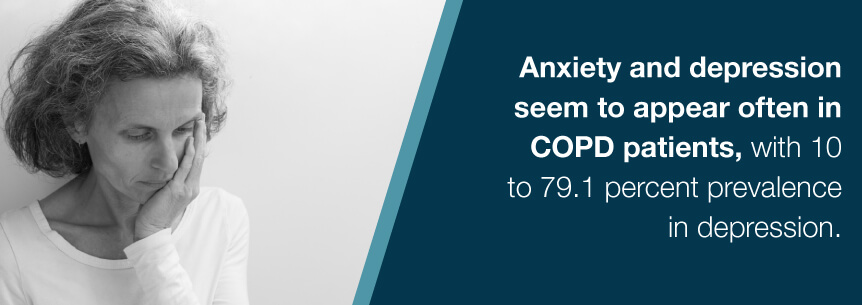
Anxiety and depression seem to appear often in COPD patients, with 10 to 79.1 percent prevalence in depression. Around 23 percent of COPD patients had major depression. Reports also show a high prevalence of poor quality of life in COPD patients.
According to the Centers for Disease Control and Prevention (CDC), for the year 2015:
The Lung Institute says:
The goal of emphysema treatment is preventing complications, providing symptom relief and slowing down the disease’s progression. Doctors urge emphysema patients to quit smoking since it further damages the lungs.
Emphysema treatments include:
Bronchodilator medications are taken orally or inhaled through aerosol sprays, bronchodilator medications relax and open your lung’s air passages providing symptom relief. Side effects of bronchodilator medications may include:
You inhale steroids through an aerosol spray to relieve emphysema symptoms related to bronchitis and asthma. Inhaled steroids, over time, may cause side effects like high blood pressure, weakened bones, cataracts and diabetes.
Antibiotics help patients with emphysema fight respiratory infections like pneumonia, acute bronchitis and the flu. Side effects of antibiotics may include:
Emphysema patients should get a pneumonia shot every five to seven years and flu shot every year to prevent infections. All vaccines have the potential of causing side effects. These are minor side effects for the most part like a low-grade fever or arm soreness, and they typically take a couple days to disappear. Although rare, more serious side effects may include serious allergic reactions and seizures.
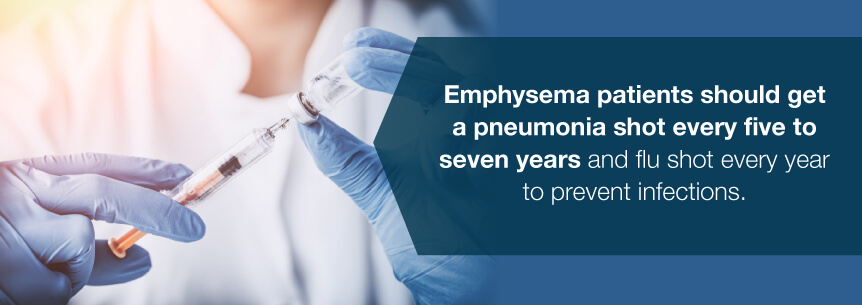
When patients’ emphysema is due to an AAT deficiency, they may receive AAT infusions to help slow down lung damage progression. High doses of protein therapy may cause side effects such as:
As your disease progresses, you may find it harder to breathe by yourself and might need supplemental oxygen. Oxygen may come in different forms and devices, such as oxygen-gas cylinders and oxygen concentrators.
Pulmonary rehabilitation is a program of education, support and exercises helping you learn how to function and breathe at the highest possible level.
During this program, you will work closely with a specialist team who will assist you in improving your physical condition. They’ll teach you how to effectively manage your emphysema so you’re active longer and healthier once you’ve finished the program. Your doctor will need to refer you and show you have COPD through spirometry test results in order for you to qualify for this program.
During pulmonary rehabilitation, you’ll also learn about:
You’ll learn coping skills for changes as a result of your COPD like anxiety, depression, panic and more. You’ll meet others going through the same thing with the same feelings and experiences as you.
With emphysema, you may require a lung transplant or a lung volume reduction surgery where the surgeon removes small parts of the tissue from your damaged lung. Side effects of lung transplant may include:
Before any treatment, sit down with your doctor and discuss any potential side effects so you know what you should expect.